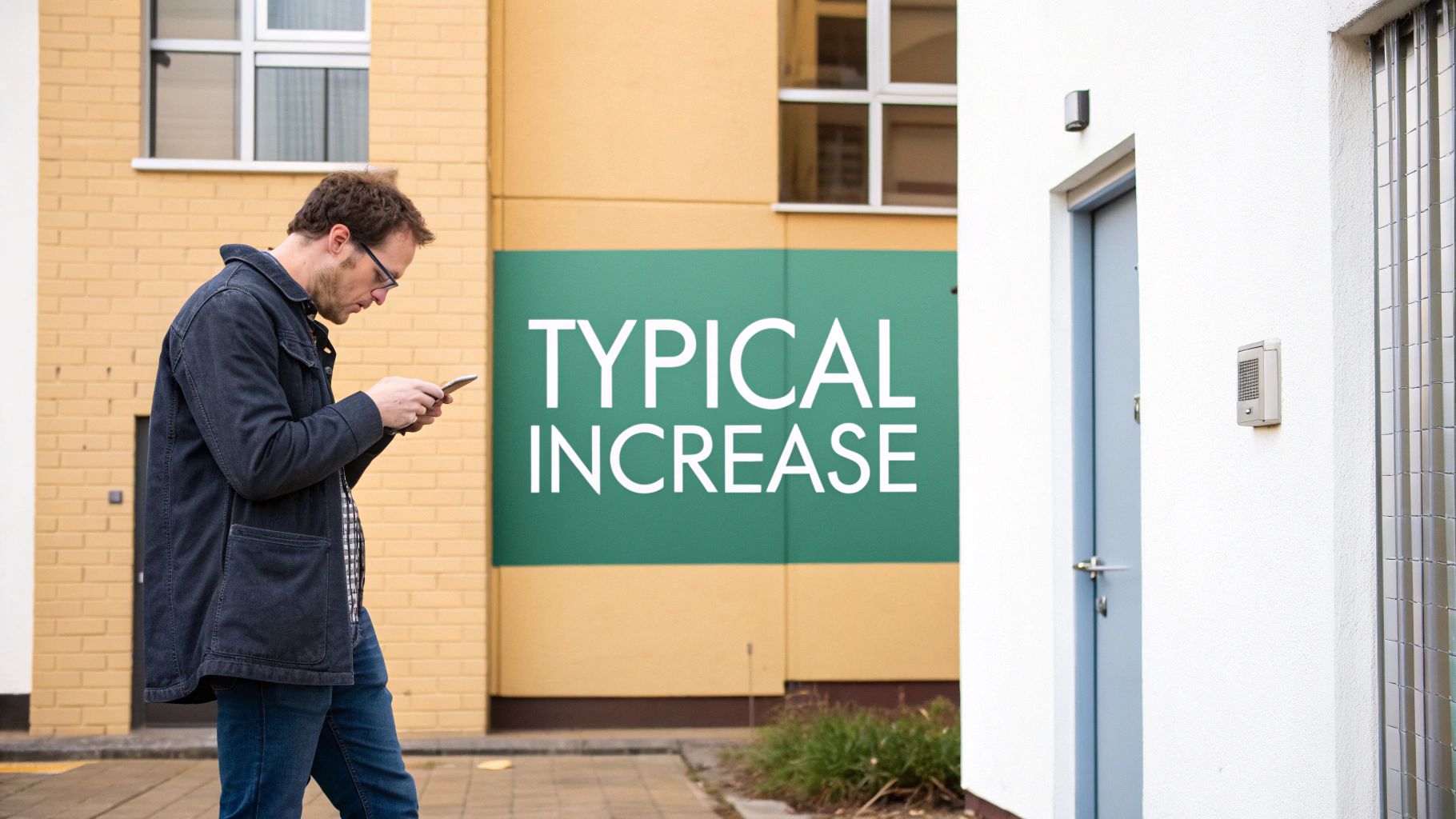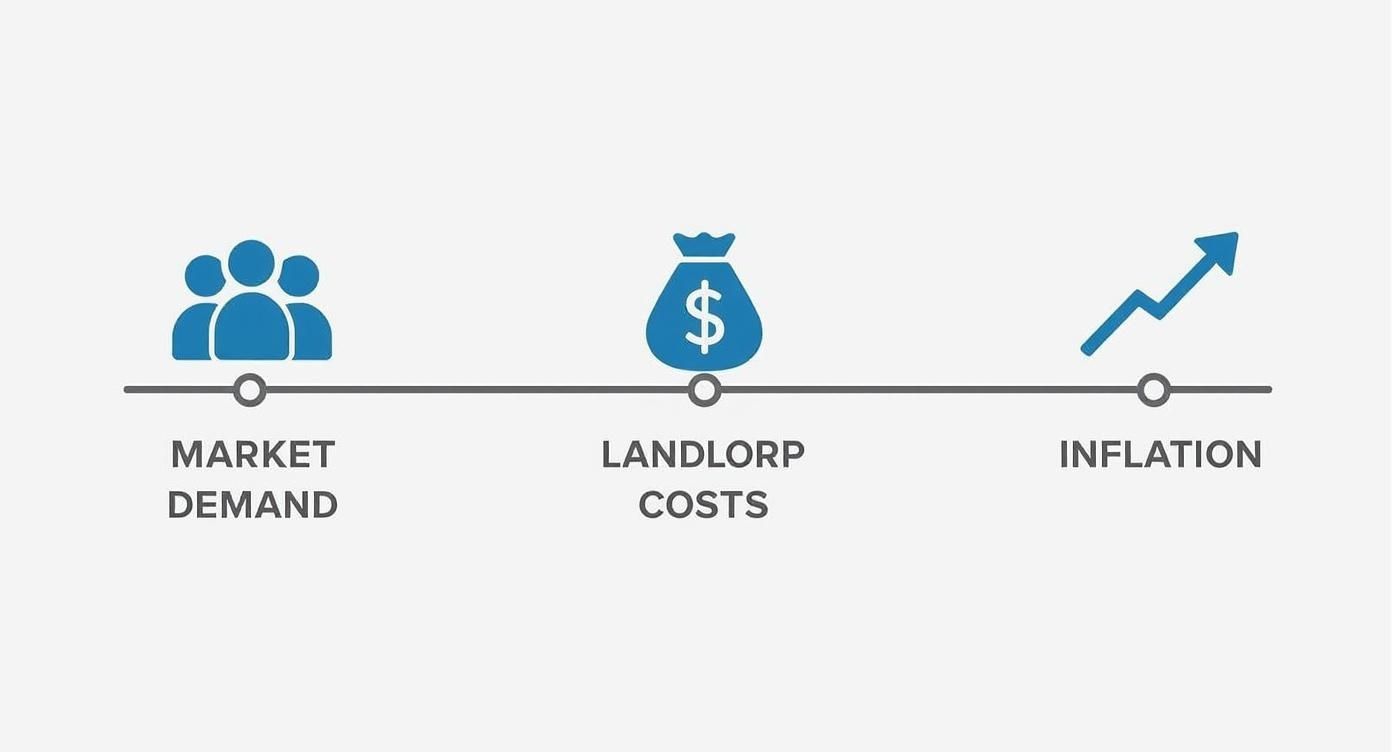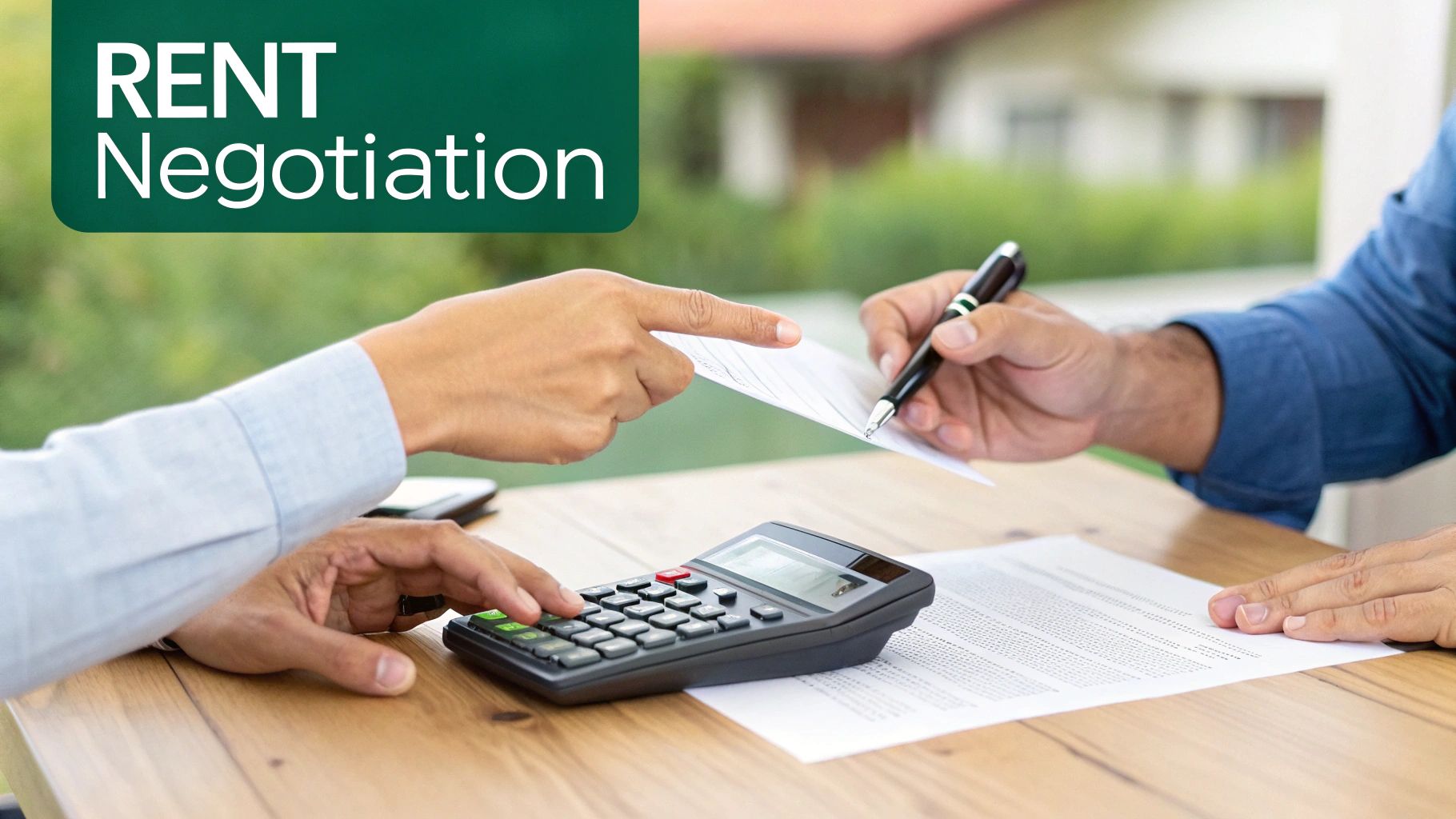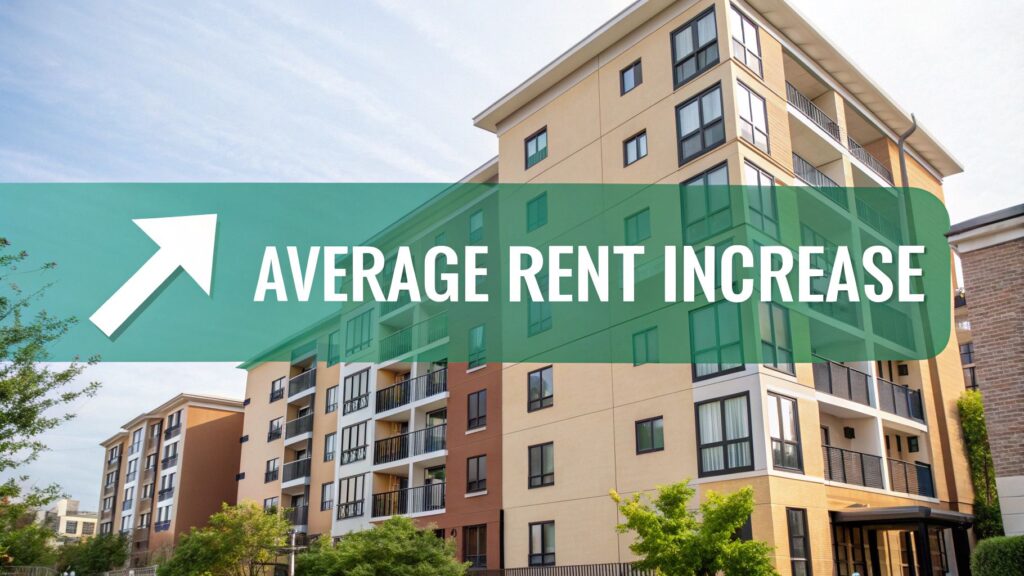If you've been renting for a while, you've probably heard that a "typical" annual rent increase is somewhere between 3% and 5%. But treating that as a hard-and-fast rule is a bit like expecting the weather to be perfectly average every day. It just doesn't account for the economic heatwaves and market cold fronts that shape what you actually pay.
The real average rent increase is a moving target, heavily influenced by your specific city, the local economy, and the broader national housing climate.
Understanding The Typical Rent Increase

It helps to think of that 3-5% range as a general guideline—a calm sea before the storms of inflation or intense housing demand roll in. For renters in hot markets like Boca Raton, that baseline often feels more like a distant memory than a current reality.
Several powerful forces are constantly at play, pushing that number up or down. When it comes time to renew your lease, it's the combination of these factors that determines the new price your landlord proposes.
The Major Forces At Play
Getting a handle on what shapes the average rent increase helps you see what's coming and even gives you a better footing for negotiation. The biggest drivers are usually:
- Inflation and Operating Costs: When the price of property taxes, insurance, maintenance, and repairs goes up for your landlord, those costs are often passed on to you through higher rent. It's a direct reflection of the economy.
- Supply and Demand: This is Economics 101. A city with a ton of people wanting apartments but not enough units available—like so many places in Florida—is going to see steeper rent hikes. Low vacancy rates give landlords the upper hand.
- Local Market Conditions: Did a big company just move to town? Is the population booming? Things like local job growth and new residents flocking to an area can quickly crank up rental demand and send the average increase soaring.
It’s easy to think rent increases are just random numbers a landlord pulls out of thin air. In reality, they are almost always a direct reflection of a landlord's rising expenses and the economic realities of the local housing market.
To see just how much these conditions can swing, look at the historical data. The 1970s, for instance, were a wild ride with median rent growing at an explosive 8.45% per year on average, mostly because of runaway inflation.
Contrast that with the period from the 1980s to the 2000s, which saw much calmer growth, averaging under 4% annually. You can dig into more of these trends with the historical rental data on iPropertyManagement.com.
Key Factors That Shape Your Rent Increase
Here’s a quick look at the variables that can push a rent increase well above or below the national average.
| Factor | Impact on Rent Increase | Example |
|---|---|---|
| Inflation Rate | High Impact: Directly increases landlord's operating costs (maintenance, taxes, insurance), which are often passed to tenants. | A national inflation spike means the cost to repair an A/C unit or replace a roof goes up, leading to higher rent. |
| Local Job Growth | High Impact: More jobs attract more people, increasing housing demand and driving up rents due to competition for limited units. | A major tech company opens a new headquarters in your city, causing an influx of new renters and a jump in prices. |
| Vacancy Rates | High Impact: Low vacancy (<5%) gives landlords more pricing power. High vacancy forces them to be more competitive to fill units. | In a city with a 3% vacancy rate, landlords can raise rent confidently. If the rate is 10%, they may offer incentives. |
| Property Upgrades | Moderate Impact: Significant improvements to the building or your specific unit can justify a higher-than-average increase. | The landlord installs new appliances, renovates the lobby, and adds a gym, leading to a 7% increase at renewal. |
| Rental Laws | Variable Impact: Rent control or stabilization laws in some cities can legally cap the maximum allowable annual increase. | A city with rent control might limit increases to 2.5% annually, regardless of what the market is doing. |
Ultimately, the number on your lease renewal is a story told by these economic and local factors. Understanding them is the first step toward navigating the rental market with confidence.
The Hidden Forces Driving Your Rent Up
Ever wonder why your rent goes up even when your apartment stays the same? It’s easy to take it personally, but the truth is your rent is tied to a powerful economic engine humming away behind the scenes. The biggest gear in that machine is the timeless law of supply and demand.
Think of it like trying to buy tickets for a sold-out concert. When everyone wants a seat and the venue is full, prices naturally climb. The rental market works the exact same way. When a city like Boca Raton has more people hunting for apartments than there are empty units, the competition for housing heats up.
This balance is measured by something called the vacancy rate—basically, the percentage of rental units sitting empty at any given time. A low vacancy rate, especially anything under 5%, is a clear signal of a tight market where landlords have the upper hand. With a waiting list of potential renters, they can raise prices confidently, knowing someone will be willing to pay.
The Ripple Effect of a Strong Economy
A healthy economy is great news for jobs, but it often pours fuel on the fire of rising rents. When a city sees strong job growth, it acts like a magnet, pulling in new residents who all need a place to live. That sudden influx of people immediately cranks up the demand for a fixed number of apartments, pushing the average rent increase higher.
It's not just about local job numbers, either. Broader economic trends play a massive part, with inflation being one of the biggest. When the cost of everything from groceries to gas goes up, landlords feel that pinch just like the rest of us.
The price your landlord pays for property taxes, insurance, and routine maintenance isn’t static. As these operational costs increase with inflation, they are often passed on to tenants in the form of higher rent to maintain the property’s financial viability.
These aren’t just abstract ideas; they are real-world expenses that directly impact a property owner's ability to stay in business. Digging into metrics like how to calculate ROI on rental property shows just how much these financial realities drive rental prices. At the end of the day, it's a business decision rooted in rising costs.
A Landlord’s Rising Expenses
It's easy to forget about the specific costs that can force a landlord's hand. We’re not talking about optional upgrades here; these are the essential, non-negotiable expenses required to keep a building safe and livable.
Here are the most common culprits:
- Property Taxes: Local governments are constantly reassessing property values. When home and apartment building values in an area go up, so do the taxes—creating a significant and unavoidable expense for the owner.
- Insurance Premiums: This is a huge one, especially in a state like Florida. With the increased risk of natural disasters, insurance costs have skyrocketed, becoming a major driver of higher operating budgets for landlords.
- Maintenance and Repairs: The cost of both labor and materials has shot up. That simple A/C repair that might have cost $300 a few years ago could easily be $500 today. From plumbing fixes to new paint, it all adds up.
- Capital Improvements: While upgrades like a renovated lobby, modern appliances, or better security systems make the building a nicer place to live, they come with a hefty price tag. That cost is often recouped over time through small rent adjustments.
So, when that rent increase notice appears on your door, it’s rarely an arbitrary number pulled from thin air. It’s almost always the final result of all these hidden forces—from local demand to national inflation—converging right on your doorstep.
Decoding Recent Rent Market Volatility
If you've been renting over the past few years, you know it's felt like a rollercoaster. And you're not wrong—the data tells the same story. After a long stretch of relative predictability, the U.S. rental market was turned on its head by some truly unprecedented economic shifts. Getting a handle on this recent chaos is key to understanding why the whole idea of an "average rent increase" has gotten so extreme.
Think of it this way: the rental market was a calm lake, and then someone dropped a massive boulder into it. That initial splash was the post-pandemic price surge, and the ripples are the market adjustments we're all still feeling today. This period brought some of the most dramatic rent hikes in modern history, completely resetting what we consider a normal cost for rent.
The Post-Pandemic Price Surge
What caused this massive surge? It was a perfect storm, really. You had pent-up demand from people who'd put moves on hold, a jump in household savings, and a huge shift to remote work that suddenly gave people the freedom to live wherever they wanted. This created fierce competition for rentals and sent prices climbing at a dizzying speed.
The national median rent shot up an astonishing 22% from its pandemic low in early 2021 to a peak in August 2022. This wasn't just a small bump; it was the highest nominal value ever recorded, and it completely changed the game for renters.
This rapid ascent put a ton of pressure on renters' budgets, making it more important than ever to understand the big-picture trends impacting average rent prices across the country, not just in your own city.
The table below breaks down the key phases of this fluctuation, showing just how dramatic the changes were.
US National Median Rent Fluctuation
| Time Period | Median Rent | Key Trend |
|---|---|---|
| Early 2021 | ~$1,182 | The market hits its pandemic low, setting the stage for a rebound. |
| August 2022 | $1,442 | A historic peak is reached after an unprecedented 22% surge. |
| Late 2023 | $1,394 | The market "cools," but only by a modest 3.3% from its peak. |
As you can see, even after the market "cooled," rents settled on a much higher plateau than where they started.
What the Cooldown Really Means
Lately, you've probably heard news reports about the rental market "cooling down." While that's technically true, the term can be a bit misleading. A cooldown doesn't mean prices are dropping back to where they were before the pandemic. It’s more like taking a few steps down after climbing a very, very tall mountain.
The major forces behind this volatile period are pretty straightforward.

As this shows, it was the combination of intense demand, rising costs for landlords (like insurance and maintenance), and general inflation that created the perfect environment for rents to skyrocket.
Even with a slight dip, affordability is still a huge issue. After peaking at $1,442 in August 2022, the national median rent only fell by 3.3% to $1,394 more than a year later. This shows that the market has simply settled at a much higher price point. If you want to dive deeper, you can discover insights about national rent data on ApartmentList.com.
This is exactly why looking at year-over-year figures gives you a much more honest picture than getting excited about small month-to-month dips. Sure, a tiny monthly decrease might feel like good news, but the annual view shows that renters are still paying far more than they were just a couple of years ago. The bottom line is that the recent volatility has established a new, more expensive normal for renting in the U.S.
How US Rent Hikes Compare Globally
While the wild ride of the U.S. rental market might feel like a uniquely American problem, it’s really just one chapter in a much larger global story. The same economic headaches we’ve been dealing with—inflation, snarled supply chains, and massive shifts in housing demand—are sending ripples through rental markets all over the world.
Seeing this bigger picture helps frame the average rent increase not as an isolated local event, but as a shared international challenge.
However, the intensity of these rent hikes varies wildly from one country to the next. Think of it like a global weather system. While everyone feels the temperature change, some places just get a light drizzle while others are hit with a full-blown hurricane. A country’s economic health, housing policies, and population trends all mix together to create a totally unique climate for its renters.
A Look at Europe and the Asia-Pacific
Believe it or not, many international markets have seen even steeper climbs than we have in the States. In the United Kingdom, for instance, rent hikes in cities accelerated after the pandemic, with some areas seeing increases that peaked above 12% in 2023. That surge was fueled by a classic case of high demand crashing into a shortage of available properties.
The story is similar in the Asia-Pacific region. Cities like Singapore and Sydney, Australia, are stuck in a cycle of relentless rent increases, often topping 10% annually in 2024. The core of the problem there is a housing supply that just can't keep up with the flood of returning migrants and professionals.
Funnily enough, this is happening while many major U.S. and Canadian markets are finally seeing rents stabilize or even dip slightly after the craziness of 2020–2022. You can dive into the numbers yourself by exploring the full research on global property trends.
Why the Global Experience Differs
So, what causes such massive differences from one place to another? It really boils down to a few key ingredients in each nation's unique housing recipe.
- Government Policies: Some countries put a lid on things with strong rent control or stabilization laws, capping how much a landlord can raise the rent. Others operate in more of a free-market system, where prices can swing dramatically with demand.
- Housing Supply: Nations with a constant housing shortage—often due to tight building regulations or simple geography (like island-nation Singapore)—are sitting ducks for sharp rent spikes whenever demand ticks up.
- Economic Stability: In countries fighting hyperinflation, rent can skyrocket just to keep up with a currency that's losing its value by the day. More stable economies tend to have more predictable and manageable rent increases.
The global perspective really drives home one key takeaway for any renter: all rent is local. The average rent increase you see has less to do with a single global number and more to do with the specific economic and policy environment of your own city and country.
At the end of the day, the forces pushing rents up might be global, but the results are felt right in our own backyards. The recent American rental experience is just our version of a story that’s playing out very differently in cities from London to Sydney.
Your Game Plan for a Rent Increase Notice

That letter from your landlord announcing a rent increase can really make your stomach drop. But it doesn't have to be a moment of panic. Instead of reacting with emotion, take a deep breath and respond with a clear strategy.
Having a game plan puts you back in the driver's seat, allowing you to handle the situation calmly and make a decision that actually works for you and your budget. This all starts with knowing your rights.
Know the Rules of the Game
Before you do anything else, the very first step is to confirm the increase is actually legal and that your landlord followed the correct procedure. Tenant rights can change dramatically from one state to another, and even from city to city, so a little local research goes a long way.
Here’s what you need to look into:
- Notice Period: Most places require landlords to provide a specific amount of written notice before a rent hike can kick in, usually 30 to 60 days. Check to make sure the timeline on your notice follows the local law.
- Rent Control: Is your city one of the few with rent control or rent stabilization laws? If it is, there might be a legal limit on how much your rent can go up each year.
- Lease Terms: Pull out your current lease agreement. A landlord typically can't raise the rent in the middle of a fixed-term lease unless there's a specific clause that allows it.
Understanding these basic protections is your first line of defense. It confirms the proposed increase is on the level and gives you a solid foundation for whatever you decide to do next.
Prepare for a Productive Conversation
Once you’ve confirmed the notice is legal, you can decide if you want to try and negotiate. A lot of tenants just assume the new price is set in stone, but that's not always true. A good landlord knows that a reliable, long-term tenant is worth their weight in gold, and that’s your biggest bargaining chip.
To get ready, do your homework. See what similar apartments in your building or neighborhood are going for. If your landlord's new rate is way above the local average, you have a solid argument for a more reasonable adjustment.
When you're ready to talk, don't forget to mention your track record as a great tenant—you always pay on time and you take care of the place. You could even offer to sign a longer lease, say for 18 or 24 months, in exchange for a smaller increase. Landlords love stability. For more tips, check out our guide on how to negotiate rent price.
Decide Your Next Move
Ultimately, you have to crunch the numbers and figure out what’s best for you. Calculate the total yearly cost of the new rent. Then, compare that to the very real costs of moving—hiring a truck, paying new security deposits, and covering application fees.
If the increase pushes your current apartment out of your budget, it's time to start looking for a new place. If your plan involves a move, you might need to look into practical moving home storage solutions to help with the transition. Whether you stay and negotiate or decide it's time to go, making an informed choice is what gives you control.
Got Questions About Rent Hikes? We've Got Answers
Let's be honest, getting a notice that your rent is going up can be stressful. It's a topic filled with confusion and more than a little anxiety. What are the rules? Can you fight it? What's considered "normal"?
We get these questions all the time. So, let's break down the most common concerns and give you some straight answers. Knowing your rights and options is the best way to approach the situation with a clear head.
How Much Can a Landlord Actually Raise the Rent?
This is the big one, and the answer almost always comes down to your local laws. In most of Florida, and in many places across the country without rent control, there's no legal ceiling on how much a landlord can increase the rent between leases. The main rules are that the increase can't be for discriminatory reasons (like targeting a specific race or family status) or retaliatory (like punishing you for asking for a major repair).
Of course, they also have to give you proper written notice. But in areas with rent control laws, the game changes completely. In those cities, a local rent board usually sets a maximum percentage for annual increases. Your first move should always be to look up the specific landlord-tenant ordinances for your city or county.
Is Negotiating a Rent Increase a Real Thing?
Absolutely. It's more possible than most people think, but your approach is everything. Just saying "that's too high" probably won't get you very far. You have to treat it like a business conversation.
The secret to a good negotiation is showing your landlord why keeping you is a smarter financial move than rolling the dice on a new tenant.
Do your homework before you talk to them. What are similar apartments in your building or on your block renting for right now? If their proposed new rent is way above the going rate, you've got some powerful leverage. Remind them you've always paid on time and have taken great care of the place. You can even offer to sign a longer lease, say for 18 or 24 months. For many landlords, locking in a great, reliable tenant for longer is worth accepting a smaller rent bump.
How Often Can They Increase My Rent?
The timing is almost always tied to your lease. If you're on a typical 12-month lease, your rent is set in stone for that entire year. A landlord can't just decide to raise it in month six.
The increase usually comes when your lease is about to expire and they offer you a renewal. If you're on a month-to-month agreement, things are a bit different. Landlords can raise the rent more often, but they still have to give you proper written notice—usually 30 days is the standard. When in doubt, pull out your rental paperwork and read it carefully. To understand the nuts and bolts of these contracts, it’s helpful to read up on the components of a lease agreement.
What if I Think the Increase Is Unfair or Illegal?
If something feels wrong—like the increase seems like punishment for reporting a leak or it violates a local ordinance—your best friend is documentation. Don't rely on phone calls or verbal chats. Keep a paper trail of every single letter, email, and formal notice between you and your landlord.
Once you have your evidence organized, reach out to a local tenant's union or your city's housing authority. These organizations are incredible resources, often providing free or low-cost advice. They can look at your situation, tell you if the increase is truly unlawful, and walk you through the next steps, which could involve filing a formal complaint.
At Cynthia Gardens, we believe in transparency and fair communication. Our goal is for residents to feel secure and valued in their homes. If you're searching for a well-cared-for apartment community in Boca Raton, we'd love to show you what we have to offer. Learn more about living at Cynthia Gardens.
